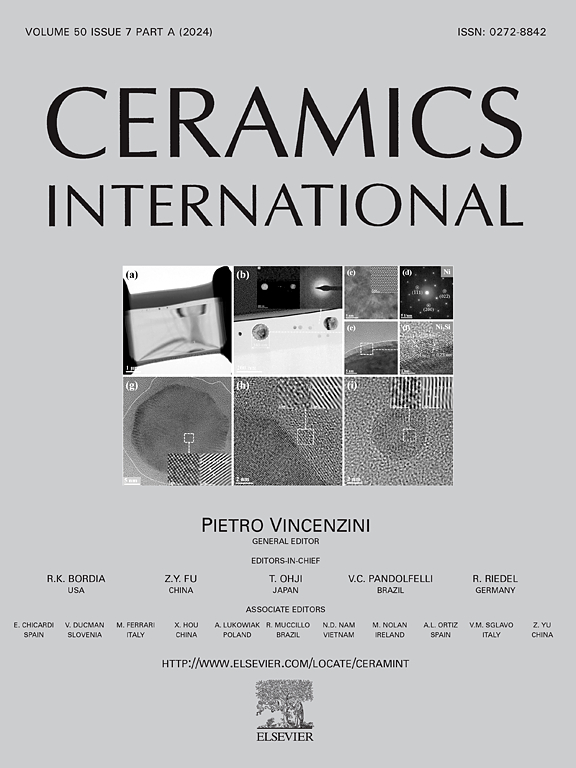Effect of Al2O3/SiO2 micro-stacked composite coatings on the high-temperature performance of AISI 304 steel
IF 5.1
2区 材料科学
Q1 MATERIALS SCIENCE, CERAMICS
引用次数: 0
Abstract
Al2O3/SiO2 micro-stacked composite coatings with varying deposition sequences were fabricated on AISI 304 stainless steel to enhance their performance for applications exceeding 850 °C. Single coatings of Al2O3 and SiO2, as well as Al2O3-SiO2 (A-S) mixed coating, were prepared for comparative analysis. After 100 h of oxidation treatment at 900 °C, X-ray diffraction (XRD), scanning electron microscopy (SEM) and energy spectrum analysis (EDS)were used to investigate their high-temperature performance. The results demonstrated that all coatings effectively enhanced the high-temperature performance of stainless steel. The antioxidant properties of the coatings were ranked: coatings with SiO2 applied first (SSA, SAS) > coatings with Al2O3 applied first (ASA, AAS) > single coatings (AAA, SSS), revealing that the deposition sequences significantly effected the high-temperature performance of coatings. The combination of Al2O3 and SiO2 facilitates the formation of a more protective composite oxide, exhibiting complementary high-temperature antioxidant properties. The low mass gain of the A-S mixed coating and its high oxidation spallation indicate limited improvement in the antioxidant properties. A partial metallurgical bond layer has formed in the interface of coating/substrate for micro-stacked composite thin coatings with SiO2 applied first, which contributes to lower oxidation spallation thus the better oxidation resistance. The SAS micro-stacked composite thin coating demonstrated the best high temperature oxidation resistance, with mass gain and oxidation spallation of 41.2 % and 29.9 % respectively compared to those of the blank stainless steel sample.
Al2O3/SiO2微堆积复合涂层对AISI 304钢高温性能的影响
在AISI 304不锈钢上制备了不同沉积顺序的Al2O3/SiO2微堆积复合涂层,以提高其在850°C以上的应用性能。制备了Al2O3-SiO2单一涂层和Al2O3-SiO2 (A-S)混合涂层进行对比分析。900℃氧化处理100 h后,采用x射线衍射(XRD)、扫描电镜(SEM)和能谱分析(EDS)对其高温性能进行了表征。结果表明,所有涂层均能有效提高不锈钢的高温性能。涂层的抗氧化性能排序为:SiO2涂层优先(SSA、SAS);先涂Al2O3涂层(ASA, AAS) >;单一涂层(AAA, SSS),表明沉积顺序对涂层的高温性能有显著影响。Al2O3和SiO2的结合有利于形成更具保护性的复合氧化物,具有互补的高温抗氧化性能。A-S混合涂层的质量增益低,氧化剥落率高,表明其抗氧化性能改善有限。先涂SiO2的微堆积复合薄涂层在涂层/基体界面形成部分冶金结合层,有利于降低氧化剥落,提高抗氧化性能。与空白不锈钢相比,SAS微堆积复合薄层的质量增益和氧化剥落率分别提高了41.2%和29.9%,具有最佳的高温抗氧化性能。
本文章由计算机程序翻译,如有差异,请以英文原文为准。
求助全文
约1分钟内获得全文
求助全文
来源期刊

Ceramics International
工程技术-材料科学:硅酸盐
CiteScore
9.40
自引率
15.40%
发文量
4558
审稿时长
25 days
期刊介绍:
Ceramics International covers the science of advanced ceramic materials. The journal encourages contributions that demonstrate how an understanding of the basic chemical and physical phenomena may direct materials design and stimulate ideas for new or improved processing techniques, in order to obtain materials with desired structural features and properties.
Ceramics International covers oxide and non-oxide ceramics, functional glasses, glass ceramics, amorphous inorganic non-metallic materials (and their combinations with metal and organic materials), in the form of particulates, dense or porous bodies, thin/thick films and laminated, graded and composite structures. Process related topics such as ceramic-ceramic joints or joining ceramics with dissimilar materials, as well as surface finishing and conditioning are also covered. Besides traditional processing techniques, manufacturing routes of interest include innovative procedures benefiting from externally applied stresses, electromagnetic fields and energetic beams, as well as top-down and self-assembly nanotechnology approaches. In addition, the journal welcomes submissions on bio-inspired and bio-enabled materials designs, experimentally validated multi scale modelling and simulation for materials design, and the use of the most advanced chemical and physical characterization techniques of structure, properties and behaviour.
Technologically relevant low-dimensional systems are a particular focus of Ceramics International. These include 0, 1 and 2-D nanomaterials (also covering CNTs, graphene and related materials, and diamond-like carbons), their nanocomposites, as well as nano-hybrids and hierarchical multifunctional nanostructures that might integrate molecular, biological and electronic components.
 求助内容:
求助内容: 应助结果提醒方式:
应助结果提醒方式:


